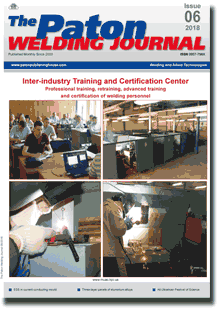| 2018 №06 (01) |
DOI of Article 10.15407/tpwj2018.06.02 |
2018 №06 (03) |

The Paton Welding Journal, 2018, #6, 9-19 pages
Effect of liquid glass composition and structure on the strength of low-hydrogen electrode coatings
A.E. Marchenko1, V.V. Trachevsky2 and N.V. Skorina1
1E.O. Paton Electric Welding Institute of the NAS of Ukraine 11 Kazimir Malevich Str., 03150, Kyiv, Ukraine. E-mail: office@paton.kiev.ua
2Technical Center of the NAS of Ukraine 13 Pokrovskaya Str., 04070, Kyiv, Ukraine. E-mail: tracev@imp.kiev.ua
The paper presents the results of investigations of the strength of coatings of low-hydrogen electrodes, baked at 200, 300 and 400 °C, depending on the composition of liquid Li-, Na- and K-glasses, as well as their binary mixtures. Investigation results were interpreted from the viewpoint of evolution of silicon-oxygen structure of liquid glasses under the conditions of changing kind and ratio of cations-modifiers, as well as the level of water content, related to the parameters of electrode heat treatment. Diagnostics of structural-functional self-organization of silicon-oxygen anions (SOA) in the liquid glass composition was performed with application of the data of nuclear magnetic resonance (NMR). NMR29Si spectrum was used. The generalized results were considered in terms of dominance of polycondensation mechanism. A correlation was established between the values of coating strength and ratio of bridge Q4, Q3, Q2 and non-bridge Q1 connectivities in SOA structure. 8 Ref., 4 Tables, 12 Figures.
Keywords: arc welding, welding electrodes, manufacturing technology, liquid glass, liquid glass structure, application of NMR spectroscopy method
Received: 13.04.18
Published: 05.07.18
References
- Gorpenyuk, V.N., Pokhodnya, I.K., Marchenko, A.E. (1971) About procedure of evaluation of electrode coating strength. Proizvodstvo, 8, 45–46 [in Russian].
- Brykov, A.S. (2009) Silicate solutions and their application: Manual. St.-Petersburg, St.-PGTI (TU) [in Russian].
- Lukyanova, O.I., Uvarova, I.Yu. (1967) To study of interaction between high-basic calcium silicates and high-silica sodium silicates. Doklady AN SSSR, 172 (3), 645 [in Russian].
- Marchenko, A.E., Skorina, N.V., Voroshilo, V.S., Shevchenko, L.A. (1979) On some technological problems caused by interphase processes in production of welding electrodes. CMEA, Coordination Center on Problem of Development of Sci. Principles... Information documents. Kiev, Naukova Dumka, 1, 50–157 [in Russian].
- Uchino, T., Sakka, T., Iwasaki, M.-J. (1991) Interpretation of hydrated states of sodium silicate glasses by infrared and Raman analysis. Ceram. Soc., 4(2), 306–313. https://doi.org/10.1111/j.1151-2916.1991.tb06880.x
- Marchenko, A.E., Skorina, N.V., Kiselev, M.O. et al. (2017) Nuclear magnetic spectroscopy study of the structure of liquid glasses for welding electrodes. The Paton Welding J., 1, 41–45. https://doi.org/10.15407/tpwj2017.01.07
- Marchenko, A.E. (2010) On physical-chemical nature of electrode coating strength and technological means of its assurance. In: of 5th Int. Conf. Dedicated to 20th Anniversary of Association «Electrode» on Welding Consumables. Technologies. Production. Quality. Competitiveness (7–11 June 2010, Artyomovsk, Donetskaya Reg.). Kiev, 78–99.
- Marchenko, A.E., Skorina, N.V., Suprun, S.A. (2012) Waterretaining capacity of alkaline silicates and its effect on dehydration of electrode coatings. In: Arc welding metallurgy and welding consumables. Kiev, Akademperiodika, 290–302 [in Russian].
